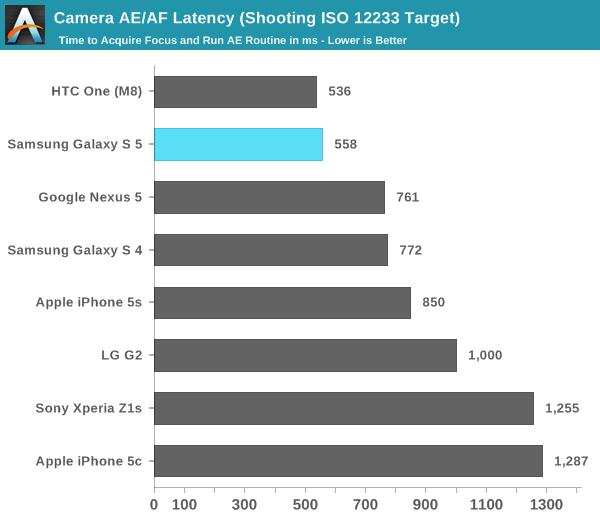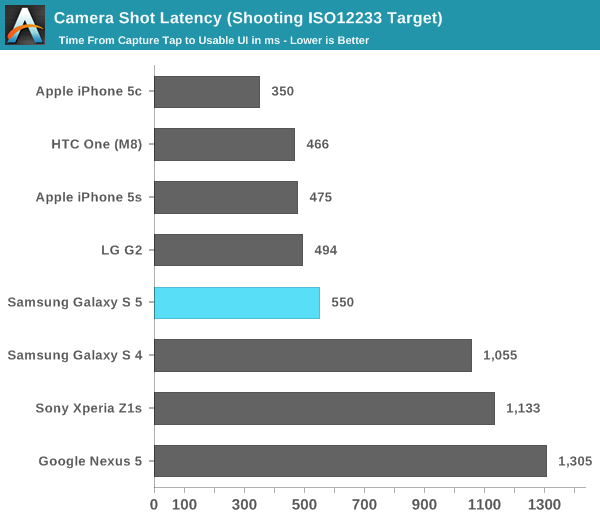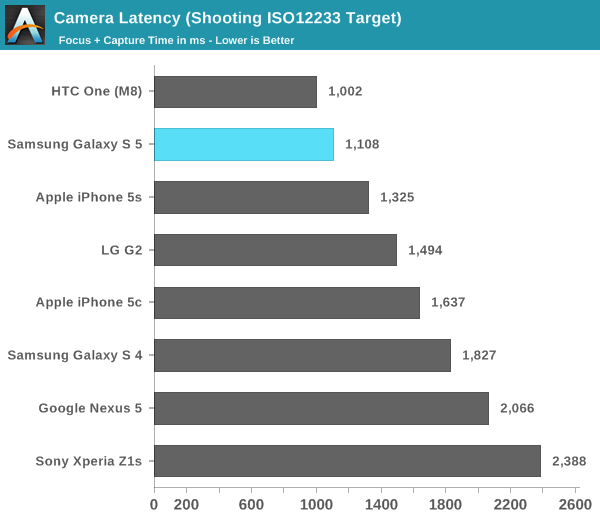Samsung Galaxy S 5 Review
by Anand Lal Shimpi & Joshua Ho on April 8, 2014 12:00 AM EST- Posted in
- Smartphones
- Samsung
- Mobile
- Galaxy S 5
Capture Latency
Along with its own rear facing camera sensor, the GS5 adapts a dual-mode autofocus system. Traditional AF designs in smartphones rely on testing contrast differences in order to determine when a point is in focus. With GS5, Samsung introduces a second mode: phase detection auto focus. Instead of relying (primarily) on contrast to determine focus, PDAF splits incoming light and compares intensity patterns to determine focus direction.
Low light scenes and scenes that can't generate appropriate phase info will default to contrast AF. PDAF appears to work across the camera's FOV although I did notice that the fastest AF times almost always happened in the center of the display.
Samsung claims a 300ms AF time thanks to its phase detection AF. In order to validate that claim I pointed a camera at a bunch of phones and measured AE/AF latency while preparing our ISO 12233 target shots from the previous page.
I measured from the moment I tapped the focus target to the time the image stopped moving (I didn't rely on the AF lock indicator as some devices report focus lock prematurely). There's a bit more variance than I'd normally like in these numbers due to the nature of the capture, although I'm working on getting a higher speed camera to smooth some of that out.

The GS5 definitely runs its AE/AF routine quickly, basically tying the M8 at the top of the charts here. The improvement over the GS4 is substantial, and there's even a big advantage over Apple's iPhone 5s. Note that if you move to lower light conditions you can see this number at least double, but that's something that impacts all of the devices here.
The Z1s is pretty frustrating because it has a great imaging system but an absolutely terrible camera UI. Focus speed is pretty bad compared to anything else here, basically on par with the iPhone 5/5c.
The shortest time to focus I was able to record on the GS5 was 450ms in a different test scene, compared to 516ms for the M8. The GS5 can definitely be a hair faster but I found the M8 to be comparable if not slightly quicker overall.
Focusing is just one piece of the puzzle, I also measured capture latency as well. Here I'm looking at the time between when I tapped the capture button on the screen and when the camera UI was ready to take another shot.

The GS5 remains solid, but here Apple actually pulls ahead. The 5c (and 5 by extension) are actually at the top of the charts here. Apple does some more work upon capture on the 5s, which is the only reason I can think of for the discrepancy here. Either that or the NAND on my 5s is in a dirtier state, impacting capture performance.
Either way there's a huge improvement in capture speed compared to the GS4. Capture latency is one area where the Nexus 5 is absolutely horrible in. The latest updates made AE/AF reasonably responsive, but the capture latency kills the experience on the N5.
This next chart combines the previous two values to give an overall picture of capture latency on these devices:

Samsung's PDAF and ISP companion seem to do their job well as the GS5 is substantially quicker than the GS4 at image capture. That being said, HTC's M8 is slightly faster by comparison.










296 Comments
View All Comments
kmmatney - Tuesday, April 8, 2014 - link
I've gone through so many micro USB cables - the lightening connector is certainly something Apple got right.ΔrNTA - Wednesday, April 9, 2014 - link
And the EU want to make all phones have a Micro USB connector as standard. That could be trouble.Arbie - Tuesday, April 8, 2014 - link
I agree: No microSD = No Sale, so the Nexus 5 is not an option.Arbie - Tuesday, April 8, 2014 - link
Yeah, streaming is possible. It's just hugely more expensive and infinitely less reliable than having what you want on an SD card. So what is your point?Asylum1621 - Tuesday, April 8, 2014 - link
When you say "I can see why Samsung would want to optimize for these two cases as they are quite common in regular usage" what is this based on? Usage models show that >90% of commands sent to eMMC during regular usage are 4k random writes. Sequential read and write is rarely used in the system, and most sequential read/write events are not dependent on eMMC having great sequential performance, ie video playback, recording video using built-in camera, etc.kelemvor33 - Tuesday, April 8, 2014 - link
I'd love to see the GS3 in some of these charts to get a good comparison of how the GS line has improved over time. I have a GS3 and my 2 years is up this fall so the GS5 will be an option for me. The GS4 wasn't due to timing so having the 3, 4, and 5 in there would be more beneficial info to have.rrecine - Tuesday, April 8, 2014 - link
Metal does not mean a phone is built better than another phone. Metal is for isheep and magnets.akdj - Wednesday, April 9, 2014 - link
Must not have read...or comprehended the review? Metal is an incredible conductor of heat, a natural 'heatsink' for the 'guts'. See the scores in the M8 vs S5? Consistently higher benchmarks and faster, longer performance without throttling due to the ability of metals to dissipate that heat. Plastic is more insulator than anything. I own the Note 3, had the S3 and original Note as well. Metal, Apple's 'plastic' and all the Nokias I've seen have significantly better plastic build quality than my Sammys. To defend samsung and their use of extremely cheap 'housings' on the high end phones is silly. Kinda the joke of the entire industry. Such cool ideas, fast processing, great displays and digitized screens with styli... Yet they have FINALLY gotten around to improving TouchWiz...a bit more refined this time around, still kinda 'old' looking and heavy with crap you won't use...NOR have they increased or 'bettered' their manufacturing process when it comes to building the phone housing. I'm not saying it HAS to metal, though the iPhone is gorgeous, as are the latest HTCs and XPerias...but plastics can be molded, hardened, shined up and 'feel' solid if done right. Samsung's cheap rear plate is a joke. Nice to access a battery, but I've never owned a second one...my Note 3 will last two days. Nice to have the SD storage. And IMHO they actually did a pretty good job with the N3's 'textured' faux leather design on the black model. I'll hold judgement on this one til I see it...but @ 5.1" it's starting to creep into that Note/Phablet territory...one a bit more niche than the typical user. I love my Note3 but it's a two handed device for everything and anything I do with it. Even after owning one for two and a half years, I still hate using it as a phone. Too damn big. But anymore, talking on our phones is tertiary. MMS,SMS, Facebook and Twitter, emails and texts. So many more efficient ways to communicate. But when you've got to make a call, it's nice to have a comfortable phone. I love the iPhone for a lot of reasons, but a big one is the ease of one handed use. While the N3 has the 4" small screen option, the hardware is still in the same spot so it's kinda useless with the exception of phone dialing or single handed texting.doobydoo - Friday, April 11, 2014 - link
Good post.maecenas - Tuesday, April 8, 2014 - link
"Pretty much all the flagships offer some set of tradeoffs that prevent any one from being the perfect device (iPhone's screen size...)"Not really what I would choose to knock the iPhone - in my opinion the iPhone is about the right size and screen size is a knock against pretty much everyone else. That said, iPhone doesn't allow MicroSD expansion, doesn't feature different screen size options, has the closed Apple environment, charges outrageous prices for storage expansion - there are a lot of less subjective criticisms that can be made.